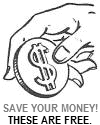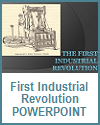| Labor Movement Printable PDF Outline |
|---|
| www.studenthandouts.com ↣ World History ↣ Industrial Revolution ↣ Industrial Revolution Outlines & PPTs |
 I. Changing employee-employer relationships
I. Changing employee-employer relationshipsa. Domestic system i. Workers and employers knew each other personally ii. Workers could aspire to become employers b. Factory system i. Workers no longer owned the means of production (machinery) ii. Employers (owners) no longer knew workers personally 1. Factories often run by managers paid by the corporation iii. Relationships between employers and employees grew strained II. Problems of the factory system a. Factories were crowded, dark, and dirty b. Workers toiled from dawn to dusk c. Young children worked with dangerous machinery d. Employment of women and children put men out of work i. Because women and children were (legally) paid less for the same work e. Technological unemployment—workers lost their jobs as their labor was replaced by machines III. Poor living conditions a. Factories driven solely by profit i. Businesses largely immune to problems of workers b. Factory (also company or mill) towns i. Towns built by employers around factories to house workers ii. Workers charged higher prices than normal for rent, groceries, etc. 1. Workers often became indebted to their employers 2. Created a type of forced servitude as workers had to stay on at their jobs to pay their debts iii. Considered paternalistic by workers 1. Some company towns had temperance laws, etc. 2. A few employers had workers’ best interests at heart 3. But workers wanted to control their own lives IV. Slum living conditions a. Factory towns—often built and owned by factories i. Not a strange concept to rural-to-urban migrants who were used to living on a lord’s estate or property ii. Full of crowded tenements iii. Few amenities b. Tenements—buildings with rented multiple dwellings i. Apartment buildings with a more negative connotation ii. Overcrowded and unsanitary c. Workers were unsatisfied both inside and outside the factories V. Rise of labor unions a. Before labor unions, workers bargained individually—"individual bargaining i. Before factories, a worker could bargain for better wages and working conditions by arguing his or her particular skills ii. But in factories, work is routine and one worker can easily replace another b. With labor unions, workers bargained together as a group, or collective—"collective bargaining" i. Organized groups of workers elected leaders to bargain on their behalf ii. Used tools (such as strikes) to gain rights VI. Weapons used by unions and employers a. Weapons used by employers i. At-will employment ii. Blacklists iii. Company unions iv. Individual bargaining v. Injunctions vi. Laws that limit union activities vii. Lockouts viii. Open shops ix. Outsourcing x. Relocation xi. Right-to-work laws xii. Threat of foreign competition xiii. Welfare capitalism xiv. Yellow-dog contracts b. Weapons used by unions i. Boycotts ii. Check-offs iii. Closed shops iv. Collective bargaining v. Direct political action vi. Favorable labor legislation vii. Feather-bedding viii. Lobbying ix. Picketing x. Sabotage xi. Strikes xii. Union label xiii. Union shops VII. British labor achievements a. Combination Laws, 1799-1800 i. Outlawed unions and strikes b. Disraeli Reform Act, 1867 i. Suffrage for workers c. 1875 i. Repeal of the Combination Laws—unions and strikes legalized ii. Union membership grew as a result d. Labour party, 1900 i. Founded by bringing together different groups representing trade unions, etc. e. Taft Vale decision, 1901 i. House of Lords ruled that unions would have to pay financial damages caused by strikes (such as loss of income to employers), which threatened to end Britain's unions f. Labour party, after 1901 i. Worked for workers' rights ii. Note: other major British political parties were Liberals (Whigs) and Conservatives (Tories) g. Trade Disputes Act, 1906 i. Protected union funds from the Taft Vale court decision ii. Achieved by Liberal and Labour parties working together h. Osborne Judgment, 1909 i. Banned trade unions from donating funds to political parties ii. Hurt the Labour party because poorer, working class party members could not provide salaries to the party's elected representatives i. Parliament Act, 1911 i. Stopped the House of Lords from vetoing laws passed by the House of Commons ii. Paid members of parliament an annual salary (so that anyone could afford to serve) j. Labour party, 1920s i. Surpassed the Liberal party in power k. Social security (a.k.a. social welfare), 1940s-1950s i. Labour party government brought increased social programs, including socialized medicine, along with government control of several industries (electricity, steel, television) VIII. Legal protections for workers a. Limited hours for women i. Later—equal pay for equal work b. Eventual end to child labor i. Schools and requirements for school attendance grew as children were removed from the workforce c. Health and safety codes d. Minimum wage e. Legalization of unions IX. Rights of female and child workers a. Women and children could legally be paid less than men for the same work i. Factory owners were more willing to hire them ii. Male workers grew resentful b. English child laborers i. England had a history (going back to the 17th century) of training pauper (poor) children (even those younger than five years old) in a trade ii. Poor children followed their mothers into factories c. Early male-dominated unions fought to banish women and children from the workplace i. Eventually this strategy was abandoned ii. Women eventually won the right to equal pay for equal work 1. Though women today, in reality, still earn less than men at the same types of work X. Social insurance/security a. Accident insurance (known as workers’ compensation in the United States) i. France, 1928; Germany, 1884; Great Britain, 1906; Italy, 1898; U.S.A., by various state laws b. Sickness insurance i. France, 1928; Germany, 1883; Great Britain, 1912; Italy, 1898; U.S.A., by various laws in some states c. Old age insurance (known as Social Security retirement benefits in the United States) i. France, 1910; Germany, 1889; Great Britain, 1908; Italy, 1898; United States, 1935 d. Unemployment insurance i. France, 1928; Germany, 1911; Great Britain, 1912; Italy, 1947; U.S.A., 1935 e. Socialized medicine (also known as universal health care) i. France, 1948; Germany, 1884; Great Britain, 1948; Italy, 1948; U.S.A., Medicaid for the very poorest citizens in the 1960s, and under President Barack Obama, conservative reforms (by international standards) are set for all Americans in 2014 XI. Review Questions a. How and why did employer-employee relationships change during the Industrial Revolution? b. Describe living conditions in factory towns. c. Describe the weapons used by employers and unions. d. Why was the establishment of yearly wages for members of Parliament important to the British Labour party? e. What are the advantages and disadvantages of unions for workers and consumers? Click here to print. This outline prints as four sheets, or as two double-sided sheets. |
 |  |  |  |
| www.studenthandouts.com ↣ World History ↣ Industrial Revolution ↣ Industrial Revolution Outlines & PPTs |








